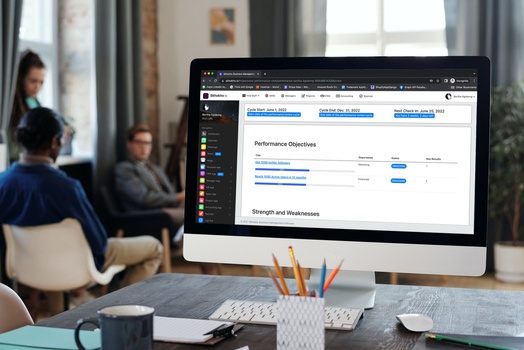What is Employee Development? It's Benefits and Importance
This article will explain what employee development actually means. Then we'll explore many other aspects such as the benefits for the business and how different strategies can help develop the employee.
We'll talk about how HR professionals are able to design actionable employee growth plans. As Human Resources or Learning & Development specialists, employees are a very valuable asset to the company.

What is employee development?
Employee development is a process through which employees improve their skills and abilities in order to perform their jobs more effectively. Development activities may include training, mentoring, and coaching.
Professional growth doesn't just focus on maximizing one's talents, but also on helping the professional develop their career through ongoing training.
Importance of Employee Development
The importance of employee development cannot be understated. Employees who contribute their whole lives to a company also deserve rewards. Money may be an incentive, but they also desire to prepare for the future. Employees must develop with time, which means employee development is crucial to maximize their effectiveness.

The employee really needs to boost the career while employers should encourage the employee to start reading books. Employee development is the helping an employee to perform periodic self-analyses in order to identify and measure the gap between the current and desired status.
Why is development planning important for businesses?
Development planning is important for businesses because it helps to ensure that employees are working towards common goals and objectives. It also helps to identify and groom future leaders within the organization. Development planning can help to improve employee morale and retention, as well as boost productivity and efficiency.

Now that we understand the importance of employee development and why development planning is important for a business, let us now look at the overall benefits of putting together an effective employee development plan.
We will then look in to what that employee development plan should look like and how to create one for your employees.
The benefits of doing effective employee development for a business
1. Increased productivity
One of the most important benefits of doing effective employee management is increased employee productivity. Because employee development helps employees improve on their skills and ability, this leads to better performing employees and higher productivity for the business.
2. Improved morale
Employee development can also lead to improved morale within the workplace. When employees feel that they are able to improve their skills and abilities, they feel more valued by the company. This leads to higher morale and motivation to do their best work.
3. Greater retention
Another important benefit of employee development is greater retention of employees. When employees feel that they are able to develop their skills and abilities, they are more likely to stay with the company. This leads to a lower turnover rate and saves the business money in the long run.

4. Improved customer satisfaction
Employee development can also lead to improved customer satisfaction. When employees are better trained and have the ability to improve their skills, they are able to provide better service to customers. This leads to happier customers and repeat business.
5. Greater profitability
All of these benefits ultimately lead to one thing: greater profitability for the business. When employees are more productive, have higher morale, and provide better service to customers, the business will see an increase in profits. Employee development is an important part of any successful business.
Skhokho Employee Development Software Tool and Employee Development
The Skhokho employee development software tool is designed to help managers with team administration responsibilities, including team task management, goal setting and management, and performance management. Performance management can be used to develop employee skills and capabilities.

The Skhokho HRMS can be used for employee development in several ways. First, the software can be used to track employee performance and identify areas where improvement is needed. Second, the software can be used to set goals and objectives for employees and track their progress towards those goals. Finally, the software can be used to provide feedback to employees on their performance.
The Skhokho employee development software tool can help managers to improve employee performance and skills. By tracking employee performance, identifying areas for improvement, setting goals, and providing feedback, the tool can help managers to develop their employees in a way that benefits both the employees and the organization.
Get Started with Skhokho HRMS
Register for a 14 Day Free Trial Here: https://skhokho.io/authentication/register
How do I create a strong employee development plan?
Increasingly, employers struggle to attract new hires to the company due to employee revaluations of their job priorities. When implementing your professional development plan, you should consider implementing an employee development plan for your team.
Adapting an employee plan is crucial. Industry and personnel size will also be influenced, but learning styles, preference, and subject matter accessibility must also be taken into consideration.

Step by step guide to creating an employee development plan
Step 1: Assess where your employees are currently at
The first step to creating an employee development plan is to assess where your employees are currently at. This includes looking at their skills, knowledge, and abilities. It also includes looking at their motivation and engagement levels.
The assessment should look at the employee's specific job role and responsibilities. Answer the question, what are the current capabilities of the employee as it relates to their job description.
- Practical Example
For example, if your employee is a Business Analyst, you would want to consider the current employee skills and abilities for the Business Analyst role.
Step 2: Determine where you want your employees to be
The second step is to determine where you want your employees to be. This includes looking at where you want them to be in the short-term, medium-term, and long-term.
- Practical Example
For example, if in the short-term you want your Business Analyst to be able to create process maps, in the medium-term you want them to be able to lead process improvement projects, and in the long-term you want them to be able to train other employees on process mapping.
Step 3: Create a Plan of Action
The third step is to create a plan of action. This includes creating specific and measurable goals. The goals should be aligned with the company's strategy. They should also be realistic and achievable.
- Practical Example
For example, a goal for the Business Analyst could be to create a process map for the sales process within 6 months. Another goal could be to lead a process improvement project within 12 months.

Step 4: Implement the plan
The fourth step is to implement the plan. This includes assigning each goal to an employee. It also includes setting a timeframe for each goal.
- Practical Example
For example, the Business Analyst would be assigned the goal of creating a process map for the sales process. The timeframe for this goal would be 6 months.
Step 5: Monitor and review progress
The fifth step is to monitor and review progress. This includes tracking the progress of each employee against their goals. It also includes providing feedback and support to employees.
- Practical Example
For example, the Business Analyst would be monitored against the goal of creating a process map for the sales process. Feedback and support would be provided to the Business Analyst to help them meet this goal.
Developing effective programs for employees in the modern workforce
This can be challenging to achieve. The working landscape is constantly changing and quite competitive, which can discourage people from trying new things.
However, researchers say that formal professional development programs are becoming more popular because they help employees gain information about their career objectives. These programs also benefit multiple employees across the organization by allowing for greater learning.

Consider the learning environment of virtual, digital and remote teams
The modern working environment is changing, working from home and in remote teams is becoming the new norm in many organisations. Organisations can adapt their employee development plans to virtual teams in a number of ways to be more effective.
Provide Access to eLearning Resources
One way companies can support the learning and development of their employees in virtual teams is by providing access to e-learning resources.
This could include online courses, webinars, or e-books on relevant topics. By making these resources available, employees can learn at their own pace and in their own time.
Provide opportunities for employees to share knowledge with each other
Another way to support learning and development in virtual teams is by providing opportunities for employees to share their knowledge with each other.
This could be done through online forums, blog posts, or video tutorials. By sharing their knowledge, employees can help each other to develop new skills and improve their understanding of the work they are doing.
Offer mentoring and coaching programmes
Finally, companies can support the learning and development of their employees in virtual teams by offering mentoring and coaching programmes.
These programmes can be delivered remotely, using video conferencing or other online tools. By offering mentoring and coaching, companies can provide support and guidance to employees as they develop their skills and knowledge.









